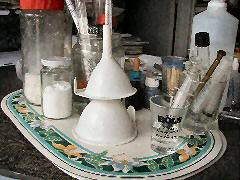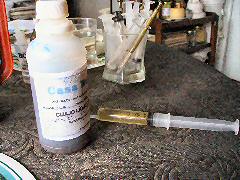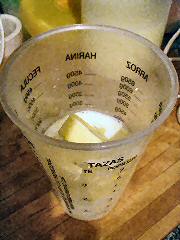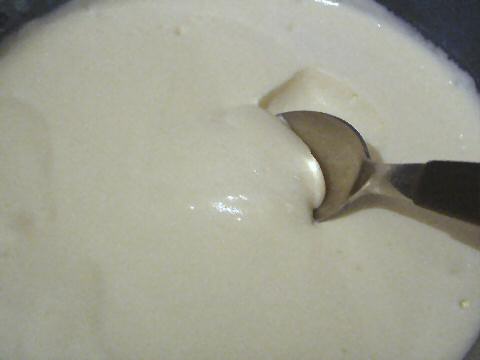“It’s the lore of the North that allows a traveller caught in a blizzard to break into a cabin for food and warmth in order to keep body and soul together. But what about breaking into an expensive condo just before Christmas, ripping open all the presents hoping to find chocolates, raiding the fridge and cupboards and pigging out on cups of tea, chilli, cream cheese and tortillas before slipping into a stupor and passing out?”
– Gerry Bellett, Vancouver Sun
Buenos Aires – Anyone possessed of functional tastebuds, who’s lived in New York City, knows that the city’s true claim to fame is a simple bagel “with a schmear” – of cream cheese, that is. Of course, New York City apparently requires a bit of propping up, since a really good schmear comes in the name of Philadelphia, not that the stuff has anything to do with the city in question…
Cream cheese originated in the United States in 1872 when a dairyman in Chester, New York, developed a ‘richer cheese than ever before,’ made from cream as well as whole milk. Then in 1880, a New York cheese distributor, A. L. Reynolds, first began distributing cream cheese wrapped in tin-foil wrappers, calling it Philadelphia Brand….The name “Philadelphia Brand cream cheese” was adopted by Reynolds for the product because at that time, top-quality food products often originated in or were associated with the city, and were often referred to as being “Philadelphia quality.” – Kraft Foods
Here in BsAs, Queso Filadelfia as it’s known (despite the “correct” spelling on the labels of the imported stuff), is the generic branding of cream cheese in general. The non-Kraft stuff is barely edible, a testament, at least, to the adherence to some standard for the name brand. Now, I promised you the best cream cheese you’ll ever taste… and I’m going to more or less deliver. I have to admit, and Hector, my cheese prof – admits as well, that this isn’t actually the recipe for true cream cheese, which is an actual coagulated cheese made with a mix of milk and cream, etc. But it’s a fascinating way to get the right taste, and more, and it follows on yesterday’s ricotta making post.
I meant, by the way, to post some photos of just what I mean by how technical things get in the classes… not that I, yet anyway, have any of this stuff at home…


 On to the “cream cheese” and an extraordinarily simple process, assuming that you’ve already made the ricotta – he swears this will not turn out right with commercial grade ricotta, and certainly, at least, here, the commercial ricotta sucks, so he may be right on that basis – though if I found some fresh stuff from a good quesería I’d give it a try – not that it’s hard, as you saw yesterday, to make your own. It’s also pretty economical, depending on how you factor in the value of time spent. The 3 liters of milk and bit of vinegar that I used to make the ricotta cost me a shade over 6 pesos, and resulted in a little over half a kilo of ricotta, plus a couple liters of whey. Commercial grade ricotta runs nearly 6 pesos for a half kilo container and is barely worth opening, and from the better cheese shops that I’ve seen, a half kilo runs anywhere between 9 and 15 pesos. So here’s the recipe… take that 600 or so grams of ricotta (less whatever you’ve already spooned into yourself), add in 100 grams of good butter, a cup of boiling milk, and mix the whole thing together with a hand blender. Add salt to taste. Taste. Try not to eat it all while still warm. Chill. Eat and be happy.
On to the “cream cheese” and an extraordinarily simple process, assuming that you’ve already made the ricotta – he swears this will not turn out right with commercial grade ricotta, and certainly, at least, here, the commercial ricotta sucks, so he may be right on that basis – though if I found some fresh stuff from a good quesería I’d give it a try – not that it’s hard, as you saw yesterday, to make your own. It’s also pretty economical, depending on how you factor in the value of time spent. The 3 liters of milk and bit of vinegar that I used to make the ricotta cost me a shade over 6 pesos, and resulted in a little over half a kilo of ricotta, plus a couple liters of whey. Commercial grade ricotta runs nearly 6 pesos for a half kilo container and is barely worth opening, and from the better cheese shops that I’ve seen, a half kilo runs anywhere between 9 and 15 pesos. So here’s the recipe… take that 600 or so grams of ricotta (less whatever you’ve already spooned into yourself), add in 100 grams of good butter, a cup of boiling milk, and mix the whole thing together with a hand blender. Add salt to taste. Taste. Try not to eat it all while still warm. Chill. Eat and be happy.

That looks great. I’m going to see if I can try that this weekend. Did you use store-bought butter or homemade? I bet the homemade variety would work wonders.
Do you think it would hold up for a baked cheesecake or would there be a good chance of it all falling apart?
I used storebought butter, but I’d bet with homemade it’d be even better. The cheesecake question is a great one and one I’d already thought about and am planning to test this coming week. I’m not holding my breath – because, I think the structure is probably off – commercial cream cheese is homogenized, and also usually has some sort of gum added to keep it in a more gelled structure. I’m guessing, that given that this is simply a blend, it might separate in the heat of an oven, and the butter might end up sort of floating about or bubbling away. But, I think it’s worth a try to find out. And who knows, it doesn’t separate when brought to room temperature, so hard to say. Possibly an extra egg or a little extra flour in the filling to help sort of seal it all together…
So, the answer is – it makes fantastic cheesecake – richer and creamier than with “filadelfia”. It doesn’t separate at all.
Great to hear and that cheesecake looks tasty. Haven’t had a chance to make the ricotta yet but when I do, its going straight to cheesecake.
So where can we find bagels? My visitors are growing weary of garlic and salt flavored baggage..
For the most part, you simply can’t. Let’s face it, bagels were invented in NYC and though they spread beyond there, they’re simply not part of the bakery world on most of the planet. You can get fairly good bagels at two places that I know of, Amaranta, on Junin near Las Heras, and at Big Mamma, on Juramento in Belgrano. Both reviewed here – you can use the search bar to find the info…. You won’t find anything like garlic or salt bagels – they’ll be plain, maybe sesame or poppy at best, and they’re still a bit anemic in comparison to a NYC bagel.
[…] no picture – a slice of cheesecake, made with my homemade cream cheese, eggs, sugar, flour, and simply flavored with lemon juice and zest and a couple of tablespoonsful […]
I will definitely use this cream cheese recipe when I make my next ricotta cheese/cream cheesecake.
[…] a cheesemaking class and all – and giving great detail on how to make ricotta, and then an amazing cream cheese substitute. And then I simply abandoned them. Not the cheese, the readers. I really haven’t abandoned […]
[…] But I wanted a prettier presentation, and this gets in a nice range of colors – there’s homemade lightly salted ricotta in the center. Surrounding that, rounds of plum tomatoes that have been drizzled with olive oil, […]
[…] & White Chocolate Cheesecake – cookie crust; white chocolate, pear, and homemade cream cheese filling; blueberries in port and Chinese five spice; grated white […]